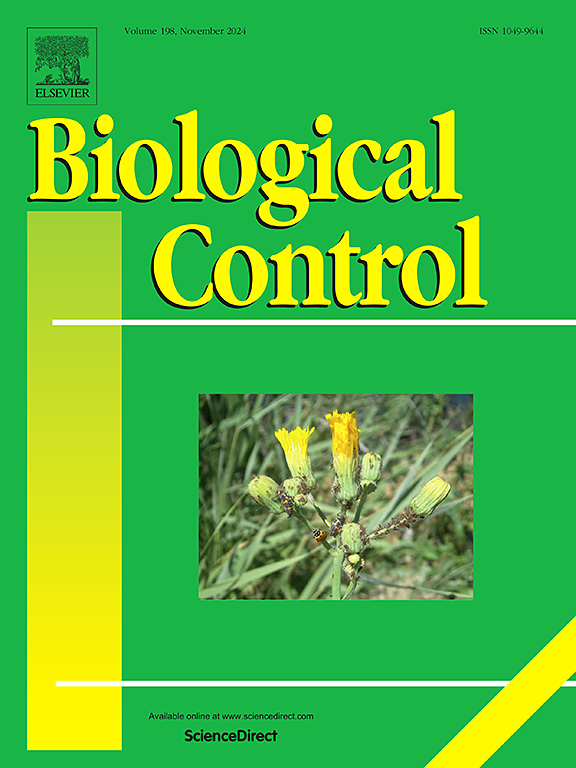生物防治对两种贮藏玉米基因型害虫存活及黄曲霉的影响
IF 3.4
2区 农林科学
Q2 BIOTECHNOLOGY & APPLIED MICROBIOLOGY
引用次数: 0
摘要
在贮藏过程中,玉米受到各种害虫的侵害,损害种子,降低其质量。控制这些害虫的一个有希望的方法是使用天敌。然而,关于天敌如何与不同玉米基因型或世代相互作用的知识有限。此外,储存害虫的存在往往为黄曲霉(最常见的储存真菌之一)创造有利条件。本研究评价了小麦谷象、玉米象和苏氏稻瘟螨3种常见贮藏害虫的天敌——tarsalbrtisocius、andandanisoptermalus和tarsalcephalonomia对它们的生物防治效果。研究了这些生物防治剂如何影响害虫的生存、果仁损伤和黄芽孢杆菌的分生孢子计数。这些性状在两种商业玉米基因型之间进行了比较:一种是表达杀虫Cry1Ab蛋白的转基因基因型,另一种是非转基因的近等距基因型。商业种子用于两种基因型(F1),以及从田间种植的转基因和近等距植物(F2)获得的种子。研究结果表明,天敌能够有效地减少害虫种群数量和害虫诱导的籽粒损伤,特别是在F2转基因基因型中。黄曲霉的存在随着籽粒损害和害虫数量的增加而增加;而天敌通过减少害虫数量抑制真菌活性,从而提高籽粒品质。总的来说,这些发现支持了将转基因抗性与生物防治相结合的综合虫害管理策略的潜力,从而提高玉米在储存期间的质量和安全性。本文章由计算机程序翻译,如有差异,请以英文原文为准。
The impact of biological control on pest survival and Aspergillus flavus in two stored maize genotypes
During storage, maize is attacked by various insect pests that damage its seeds and reduce their quality. A promising approach to control these pests is the use of natural enemies. However, there is limited knowledge about how natural enemies interact with different maize genotypes or generations. Additionally, the presence of storage pests often creates favorable conditions for Aspergillus flavus, one of the most common storage fungi. This study evaluates the biological control of three common storage pests: Sitotroga cerealella, Sitophilus zeamais, and Oryzaephilus surinamensis, by their respective natural enemies: Blattisocius tarsalis, Anisopteromalus calandrae, and Cephalonomia tarsalis. It examines how these biocontrol agents impact pest survival, kernel damage and A. flavus conidia count. These traits are compared across two commercial maize genotypes: a transgenic genotype expressing the insecticidal Cry1Ab protein and its non-transgenic near-isoline counterpart. Commercial seeds are used for both genotypes (F1), along with seeds obtained from field-grown transgenic and near-isoline plants (F2). Our findings demonstrated that natural enemies effectively reduced pest populations and pest-induced kernel damage, particularly in the F2 transgenic genotypes. The presence of A. flavus increased with kernel damage and rising pest populations; however, natural enemies suppressed fungal activity by reducing pest numbers, thereby improving kernel quality. Overall, these findings support the potential of an integrated pest management strategy combining transgenic resistance with biological control to manage pests and A. flavus, thus enhancing maize quality and safety during storage.
求助全文
通过发布文献求助,成功后即可免费获取论文全文。
去求助
来源期刊

Biological Control
生物-昆虫学
CiteScore
7.40
自引率
7.10%
发文量
220
审稿时长
63 days
期刊介绍:
Biological control is an environmentally sound and effective means of reducing or mitigating pests and pest effects through the use of natural enemies. The aim of Biological Control is to promote this science and technology through publication of original research articles and reviews of research and theory. The journal devotes a section to reports on biotechnologies dealing with the elucidation and use of genes or gene products for the enhancement of biological control agents.
The journal encompasses biological control of viral, microbial, nematode, insect, mite, weed, and vertebrate pests in agriculture, aquatic, forest, natural resource, stored product, and urban environments. Biological control of arthropod pests of human and domestic animals is also included. Ecological, molecular, and biotechnological approaches to the understanding of biological control are welcome.
 求助内容:
求助内容: 应助结果提醒方式:
应助结果提醒方式:


